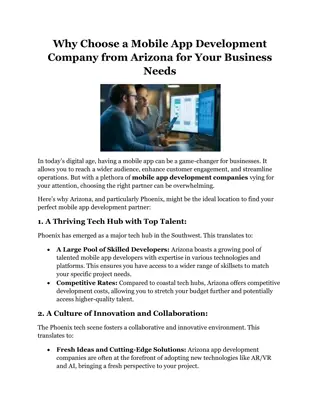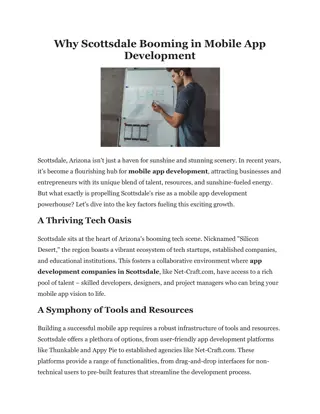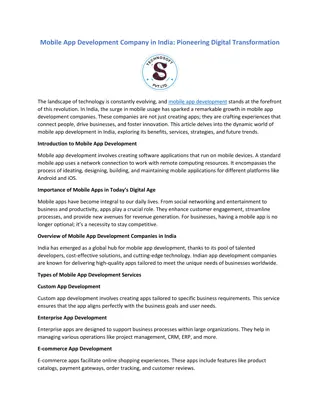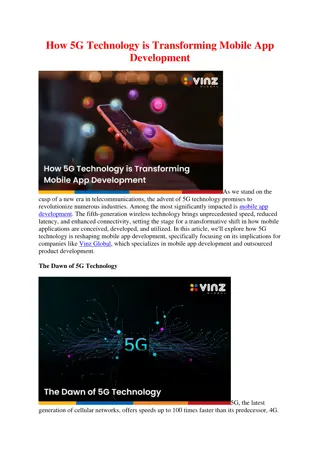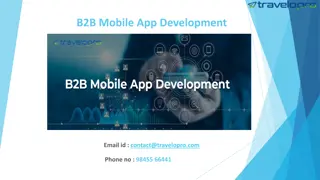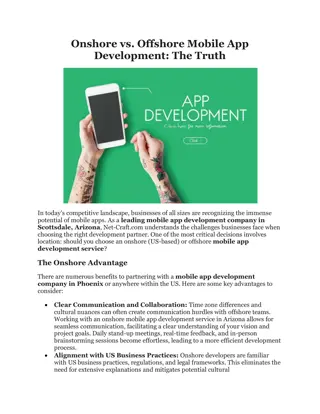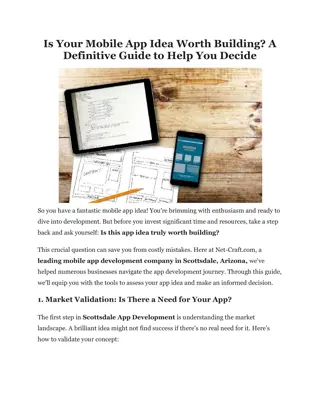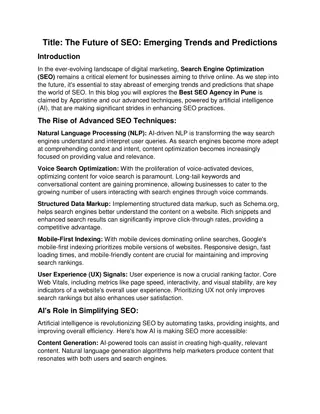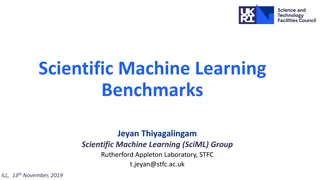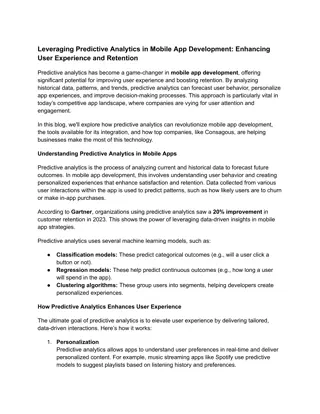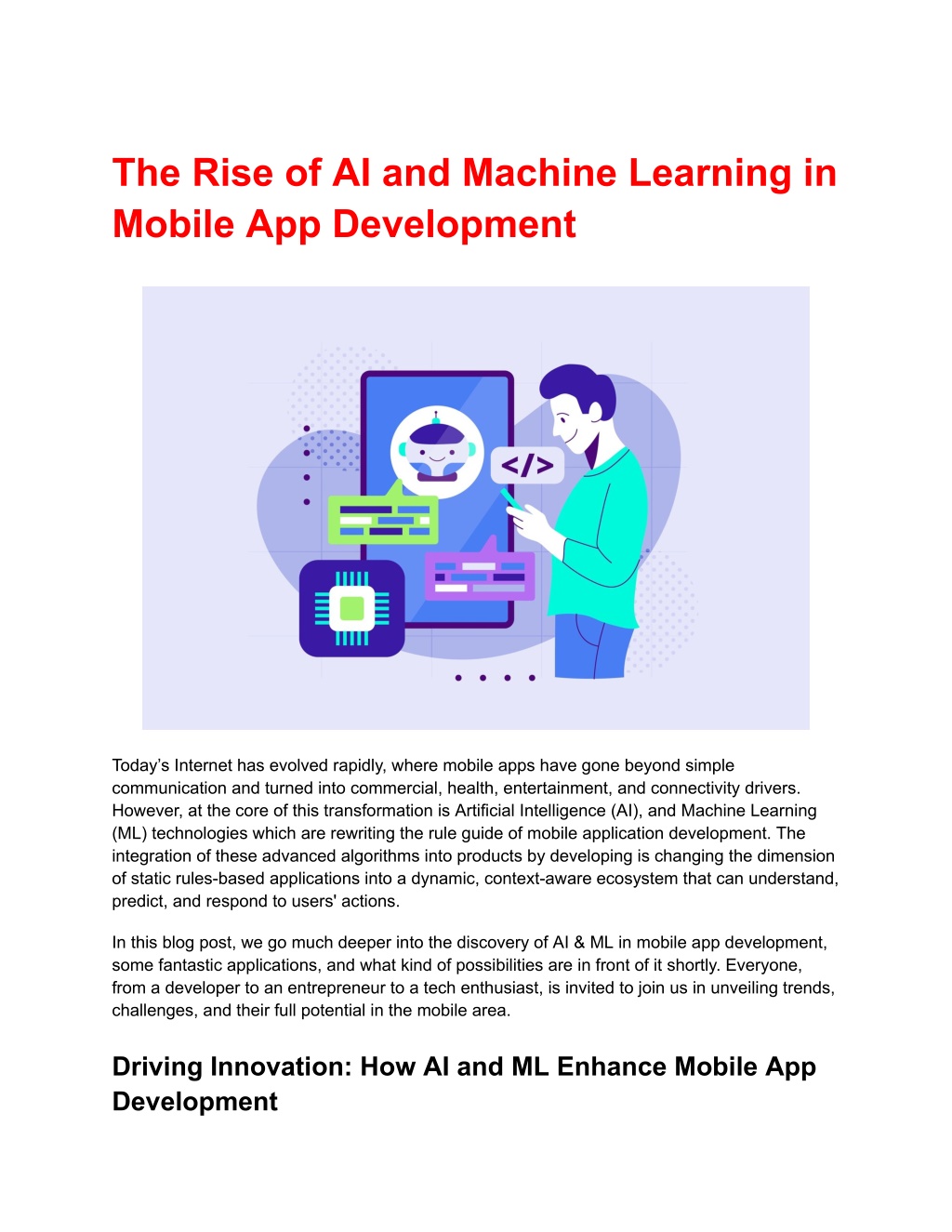
The Rise of AI and Machine Learning in Mobile App Development
AI and ML are transforming mobile apps with smart automation, personalized user experiences, and enhanced security. From AI-powered chatbots to predictive analytics, these technologies drive efficiency and engagement. This PDF explores key trends and
Download Presentation

Please find below an Image/Link to download the presentation.
The content on the website is provided AS IS for your information and personal use only. It may not be sold, licensed, or shared on other websites without obtaining consent from the author. Download presentation by click this link. If you encounter any issues during the download, it is possible that the publisher has removed the file from their server.
E N D
Presentation Transcript
The Rise of AI and Machine Learning in Mobile App Development Today s Internet has evolved rapidly, where mobile apps have gone beyond simple communication and turned into commercial, health, entertainment, and connectivity drivers. However, at the core of this transformation is Artificial Intelligence (AI), and Machine Learning (ML) technologies which are rewriting the rule guide of mobile application development. The integration of these advanced algorithms into products by developing is changing the dimension of static rules-based applications into a dynamic, context-aware ecosystem that can understand, predict, and respond to users' actions. In this blog post, we go much deeper into the discovery of AI & ML in mobile app development, some fantastic applications, and what kind of possibilities are in front of it shortly. Everyone, from a developer to an entrepreneur to a tech enthusiast, is invited to join us in unveiling trends, challenges, and their full potential in the mobile area. Driving Innovation: How AI and ML Enhance Mobile App Development
1. Personalization and User Engagement Personalization is one of the biggest benefits of AI and ML, in the sense that it allows us to provide custom experiences. AI-based apps use the data of the user such as past behavior, location, and preferences to provide only a tailor-made experience to a specific user. For instance, services such as Spotify, produce lists of music, and Netflix, generate a list of movies that have similar tastes with you, thus raising engagement and satisfaction. Personalization extends beyond content recommendations. Try out fitness apps that incorporate AI to adjust workouts according to your progress or dietary apps that give meal suggestions according to your nutritional needs. These apps build a unique experience for their users and, as a result, users are retained for longer and users loyalty improves. 2. Chatbots and Virtual Assistants Since Natural Language Processing (NLP), which is a part of AI, the intelligent chatbots and virtual assistants are coming up. Users of these tools should expect that they will interact with these tools in a hitherto, human-like way (i.e. they should answer queries, provide recommendations, and even perform tasks). Virtual assistants such as Siri, Google Assistant and Alexa are examples that would find themselves being very popularly used applications that are an important part of our everyday lives. Customer support for businesses and user interactions in an application can also be improved with chatbots. One example is that e-commerce platforms these days use chatbots to allow customers to go through the various products of the e-commerce platform, answer frequently asked questions, and also make a transaction. Nowadays, this enhances the overall user experience, reduces wait times and increases customer satisfaction thanks to the efficiency and rapidity of these interactions. Struggling with AI integration? Partner with a top AI Development company! 3. Predictive Analytics and Proactive Functionality Predictive analytics is a capability enabled by Machine learning algorithms, and every enterprise that applies machine learning will find predictive analytics to be extremely appealing. These algorithms can forecast future trends and user behavior, in effect, based on analyses of historical data. For instance, ML is used by finance apps to predict the stock market trends or to offer personalized investment advice. Ride sharing apps like Uber and Lyft have used predictive analytics to determine surge pricing, which is beneficial to both how ride takers go about their business and to hackers who want to capitalize on vacationers. Preventative healthcare apps also have a role to play in predictive functionality. Health data analysis allows these applications to predict possible health problems and therefore not only saves costs, but improves the quality of life. This allows us to see the difference in their ability to
answer the needs of the users via proactive expectations of them and traditional applications which are only reactive to them. 4. Computer Vision: Beyond the Visible Spectrum The prospects of computer vision s introduction into mobile app development is an exciting development which AI s have begun to explore. Now, mobile apps have the capability to process and interpret visual information, which was once the sole responsibility of the specialized software. For one, many augmented reality (AR) apps use computer vision to overlay digital content on top of the real world to improve gaming, education, and alternative retail experiences. Computer Vision in another popular area where it has helped a great deal, and that is face recognition. Nowadays, security apps are employing facial recognition for biometric authentication to secure more and to provide the user with a smooth journey. Moreover, computer vision is now used in many mobile apps in the healthcare sector to analyze medical images for the early detection of things such as diabetic retinopathy and skin cancer. 5. Natural Language Processing and Sentiment Analysis Mobile apps have been revolutionized by NLP in the way they process and interpret text and speech. With this information, NLP powered apps can provide more nuanced and appropriate responses. For example, NLP is being used by social media apps to detect harmful content, to filter spam, as well as suggest improvements on user generated content. Specifically, sentiment analysis, a subset of NLP, is very useful for businesses. Based on user reviews, social media comments and public comments, apps can get a feel of public sentiment and accordingly adjust its strategies. The loop is real time, whereby the companies can remain sensitive to their customers needs and respond swiftly to changing market trends. High development costs?Hire app developers in India for affordable excellence! The Technology Behind AI in Mobile Apps 1. Cloud Computing and Edge AI Cloud computing is where AI and ML algorithms need to be run, as they need a lot of computational power. Infrastructure for training complex models as well as storage of vast amounts of data are provided through the cloud platforms AWS, Google Cloud and Microsoft Azure. Cloud based AI services provide for mobile app developers, scalability and flexibility to integrate advanced features and this at low cost of investing on expensive hardware. As you can imagine, however, it is the edge computing which is gaining popularity for providing such services as the amount of data generated by mobile apps requires faster processing and
lower latency. Edge AI is about pulling computation closer to the user by processing on device, by a server near the user, or simply not processing anything at all. In addition to reducing latency, data privacy is improved because sensitive information does not have to be transmitted over the network. 2. Frameworks, Libraries, and APIs Today, developers have lots of frameworks and libraries to make their mobile app integrations with AI or ML simple. Examples of such tools include, for instance, TensorFlow Lite, Core ML, and PyTorch Mobile, which help to work with models directly on the mobile device. Pre-trained models in these frameworks come with the option to customize the features such as image recognition, language processing, predictive analytics and so on. APIs (Application Programming Interfaces) speed up the development further. IBM Watson, Google s ML Kit and Microsoft Cognitive Services are examples of services that offer ready solutions to do sentiment analysis, face detection and language translation, for example. The advantage of using these tools is that developers can concentrate on the creation of interesting user experience without having to reinvent the wheel. 3. Data: The Lifeblood of AI Data is the core of every AI and ML application. The success of these technologies hinges on the quality and quantity of data available for training algorithms. Mobile apps collect about tons of data, such as user activity and location as well as sensor data and multimedia content. It is invaluable for data to refine algorithms, as well as to make sure AI models perform correctly. Minimizing the risks of data privacy, security and ethical concerns while managing and processing this data however also presents its own challenges. On the other hand, in a case like GDPR or CCPA, developers need to be ready to follow the rules and use robust data encryption and anonymization techniques. Modern mobile app development strikes a balance between exploiting data for innovation and privacy. Challenges and Considerations in AI and ML Mobile App Development 1. Data Privacy and Security With great responsibility comes great power. The more intelligent mobile apps become, the more custodians of vast amounts of personal data they are. This data is paramount to ensuring the privacy and security of it. Data protection regulations are strict for developers, they need to
use the latest encryption methods and data must be used ethically and transparently. The problem is to use the power of AI and ML without losing user trust. 2. Model Complexity and Computational Constraints Although the processing power and battery life on Mobile devices are still far behind the processing power and battery life that traditional computers or cloud servers have, they still are quite advanced. Developing and deploying complex ML models on mobile devices can be quite challenging and they require a good amount of care when it comes to optimization of performance and the trade-offs in terms of efficiency. To make sure that AI features perform without wasting device resources, there are necessary techniques such as model compression, quantization, and lightweight architecture. 3. Integration and Maintenance Bringing in AI and ML to currently available mobile app frameworks can be an intricate process. The AI components must work hand in hand with the app s core functionalities. Furthermore, AI models are fed constantly (and are therefore always in growing state) of data and user behaviours to adapt to the ever changing data and user behaviour. This ongoing maintenance to a development is yet another complexity in adding another layer to the development life cycle. 4. Ethical Considerations Using AI in mobile apps is a heated up topic which questions the ethical side of it. Developers have to take care of bias in data, transparency in algorithms and misuse potential. The difficulty is not just technical: it s a social responsibility to create fair and unbiased AI systems. The use of AI in mobile app development requires the collaboration of developers and companies to create ethical guidelines and standards for the use of AI. Struggling with AI integration?Hire AI developers for seamless implementation! The Future of AI and ML in Mobile App Development Emerging Trends and Technologies With the evolution of technology, there is only going to be smoother adoption of AI and ML features in mobile apps. Below are a couple of trends that are most likely to define the future: The Rollout of 5G networks: 5G networks are set to bring about significantly lower latency and greater bandwidth and as a result, more complex computations which can be done in real time. This will open doors for new use cases in mobile apps that have to do with augmented reality, virtual reality, and real time analysis. Chip Technology Advancements: AI algorithms will become faster and more sophisticated, thus allowing more ML models to be deployed on mobile devices as well
as increasing capabilities on the server. By doing this, the use of cloud computing would be reduced while the users will have more privacy. Elements of AI Sloping: As platforms get better, the line between mobile as well as desktop AI applications will diminish. With this, developers will be able to come up with cross platform solutions that would give a consistent, intelligent experience to all devices. Hyper Personalization: The future mobile apps will be getting hyper personal in terms of offering data driven, context aware computing and then advanced analytics. It will make the apps more reactive and intuitive regarding the user. AI driven design tools will make interface design possibilities easier by allowing the interfaces to adapt to individual user needs, providing better User Interface (UI) and User Experience (UX). The dynamic layouts, personalized color schemes, and even adaptive accessibility features fall under this category. Impact on Various Industries Naturally, AI and ML influence is not limited to technology companies, as it is reshaping the entire industry. Wearable technology and mHealth (mobile health app) applications have made healthcare an application field where AI has been crucial and will develop with growth. Finance: finance is expected to rise in inclusivity and resistance by means of improvement of safety functions, tailor produced financial investment recommendations and resident time cyber scams. AI will continue to change the how of retail, be it recommending, shopping with AR, and store management. Mobility & Logistics will transform with Autonomous vehicles, smart traffic management & predictive maintenance systems. Personalized learning experiences of AI will enable adaptive curricula, intelligent tutoring systems and real time performance analytics for all the students of all ages. Slow development process? Speed up with reliable Mobile App Development Services! Conclusion The mobile app development community is witnessing the rise of AI and ML, which is a trend, and a revolution altogether, the way we can interact with the technology has indeed changed. AI and ML have unleashed powerful possibilities giving rise to new realms in personalization of a user experience and AI chatbots, predictive analytics and real time decision making all possible from the use of mobile technology.
The era of intelligent mobile applications has arrived and is changing the digital landscape we are but just now trying to picture. No matter whether you are a seasoned developer, an aspiring entrepreneur, or a technology fan, to know what s going on and later to take part in the making of the future in the mobile world, this is a must. We have the power today to utilize the power of AI and ML to bring the world that exists around us to mobile in a way far more dynamic, far more diverse, and far more transformative. Original Source: https://www.appclonescript.com/ai-and-machine-learning-in-mobile-app-development/








